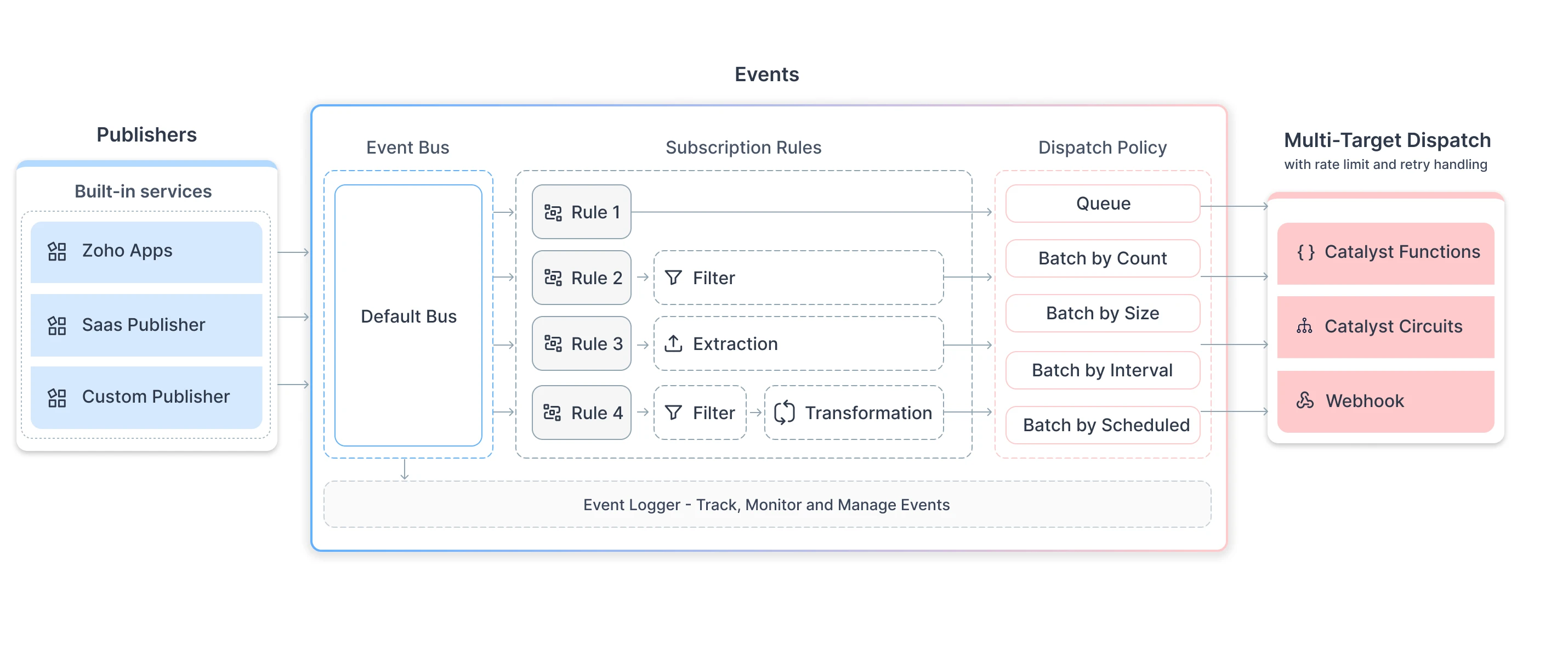What is Catalyst Signals?
Catalyst Signals is a cutting-edge event bus service that transforms how organizations adopt Event-Driven Architectures (EDAs) to streamline operations and improve efficiency. It enables near-instantaneous communication between decoupled applications and services, ensuring your workflows remain responsive, scalable, and reliable.
Signals simplifies event-driven architectures by eliminating the need for extensive coding or complex configurations. Its intuitive interface makes it easy for users across different technical backgrounds to design and manage event flows between Publishers and Targets.
Predefined Publishers and Schemas
Catalyst Signals comes with a rich collection of predefined publishers from Zoho services and Catalyst’s own CloudScale services, including Authentication, Cache, Data Store, File Store and Stratus. These services come along with default events associated with their schemas, eliminating the need for manual schema creation. For Zoho service like CRM, even custom modules are kept in sync to ensure compatibility during event transformations and webhook configurations.
Even for custom publishers, you can generate schema from live event payloads. By removing the friction of schema setup, Catalyst Signals enables quick onboarding of business-critical workflows across applications.
Flexible and Robust Event Orchestration
Once events are captured, Catalyst Signals gives you full control over how they’re processed and routed. You can define smart rules to filter and transform events, assign delivery modes, configure retries, and route events to multiple targets like webhooks, functions or circuits.
Failures during delivery can now automatically trigger Application Alerts integrated from Catalyst DevOps. This enables teams to receive real-time email notifications and take immediate action about failed events. Additionally, Connections from Catalyst’s Security & Identity services (under CloudScale) are built into the Webhook configuration, ensuring events are delivered securely to authorized endpoints with minimal effort.
Each function or circuit receiving a Signal can be monitored independently using the logs available in their respective consoles, offering deeper visibility and traceability in event flow execution.
Empowering Digital Transformation
Catalyst Signals acts as a Catalyst for businesses modernizing their systems and embracing digital transformation. By combining Signals with other Catalyst components organizations can build scalable, loosely coupled systems that rapidly adapt to changes.
Whether you’re automating internal workflows, reacting to user behavior, or synchronizing data across distributed systems, Catalyst Signals offers a flexible, low-maintenance foundation to optimize operations and drive innovation at scale.
Architecture
Let’s walk you through the outright architecture of Signals to connect with multiple cloud environments to process and deliver real-time data.
An event is a JSON-formatted message that represents a change or occurrence in a system. The Target applications listen to these events from the Publisher to perform orchestrations. In this process, the event from one software source acts as a trigger for workflows in different software. Targets receive event details through Webhooks, Functions, and Circuits.
Imagine that you have a travel and hospitality company called Travel Bureau. It has an online platform for booking accommodations, flights, and other travel related services. The company uses multiple services for handling different aspects of reservation management, customer service and support, personalized recommendations, and more.
- Booking Service: When a user makes a booking on the company’s platform, it publishes a ‘New Booking’ event to the Catalyst Signals.
- Reservation Management: The Reservation Service subscribes to the ‘New Booking’ event. Upon receiving the event, it collects the details from it, such as reservation dates, customer preferences, and service selections. With these details, it updates and manages the reservation in real-time.
- Customer Service and Support: The Customer Service also subscribes to the ‘New Booking’ event. Once the booking is completed, it reaches out to the user and inquires about any specific requirements, requests, and complaints, if any.
- Personalized Recommendations: The Recommendation Engine listens for the ‘New Booking’ event with the user’s preferences and service selections. It generates personalized recommendations for accommodations, activities, and destinations based on it. This helps in enhancing the user experience and increasing conversion rates.
Catalyst Signals connects these software sources to deliver outstanding end-user experiences and optimize operations through real-time event processing and intelligent automation.
Continue on to the next page to learn about the core elements and other features of Signals in detail.
Last Updated 2025-10-08 19:32:16 +0530 IST
Yes
No
Send your feedback to us
